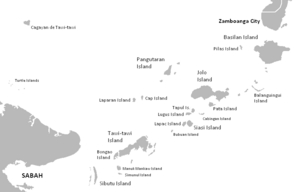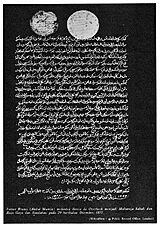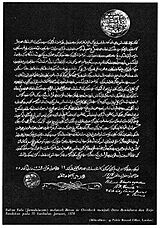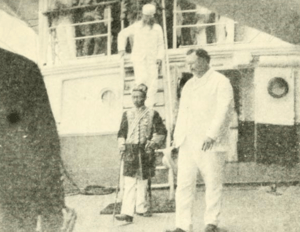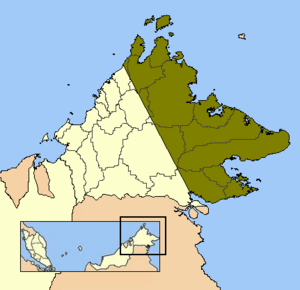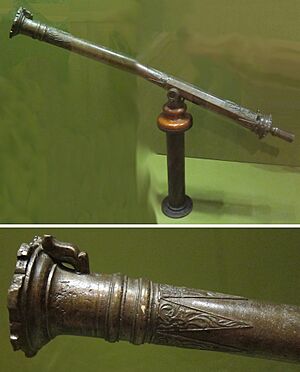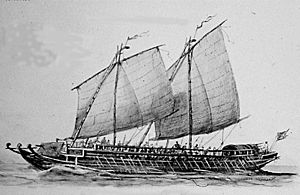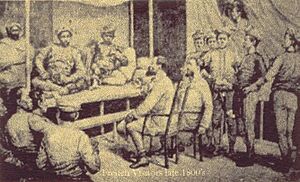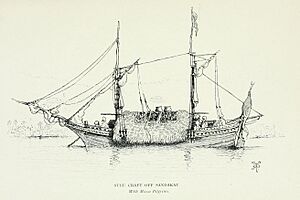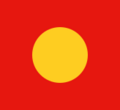Sultanate of Sulu facts for kids
Quick facts for kids
Sultanate of Sulu
كسلطانن سن سوڬ
Kasultanan sin Sūg |
|||||||||||||||||||||||
|---|---|---|---|---|---|---|---|---|---|---|---|---|---|---|---|---|---|---|---|---|---|---|---|
|
|||||||||||||||||||||||
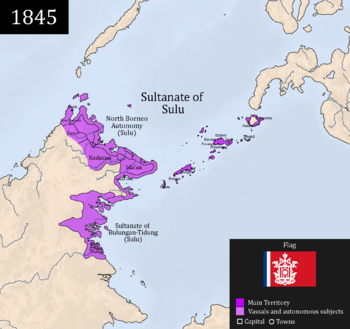
Map showing the extent of the Sultanate of Sulu in 1845, with Northeast Borneo lowlands being under its nominal control.
|
|||||||||||||||||||||||
| Status | Ming tributary (1417–1424) Bruneian vassal (1457–1578) Sovereign state (1578–1851) Qing tributary (1726–1733) Spanish protectorate (1851–1899) U.S. protectorate (1899–1915) |
||||||||||||||||||||||
| Capital |
|
||||||||||||||||||||||
| Common languages | Tausug, Sama–Bajau, Malay | ||||||||||||||||||||||
| Religion | Sunni Islam | ||||||||||||||||||||||
| Government | Absolute monarchy | ||||||||||||||||||||||
| Sultan | |||||||||||||||||||||||
|
• 1457–1480 (first)
|
Sharif ul-Hāshim | ||||||||||||||||||||||
|
• 1894–1915 (last)
|
Jamalul Kiram II | ||||||||||||||||||||||
| History | |||||||||||||||||||||||
|
• Ascension of Sultan Sharif ul-Hashim
|
1457 | ||||||||||||||||||||||
|
• Temporal power ceded to the United States
|
22 March 1915 | ||||||||||||||||||||||
| Currency | Barter with foreign traders Sulu coins for local use |
||||||||||||||||||||||
|
|||||||||||||||||||||||
| Today part of | |||||||||||||||||||||||
The Sultanate of Sulu (Tausug: Kasultanan sin Sūg) was a Muslim state in Southeast Asia. It ruled over the Sulu Archipelago and parts of Palawan in the Philippines. It also controlled areas of Sabah and North Kalimantan on the island of Borneo.
The Sultanate was founded in 1457 by Sharif ul-Hashim. He was a religious scholar from Johore. His full name was Paduka Mahasari Maulana al Sultan Sharif ul-Hashim. The Sultanate became independent from the Bruneian Empire in 1578.
At its strongest, the Sultanate's lands stretched from Zamboanga in the east to Palawan in the north. It also included parts of northeastern Borneo. Western powers like Spain, Britain, and the United States later arrived. The Sultanate lost its full power by 1915. This happened through an agreement with the United States.
History of Sulu
Early Beginnings
The area of the Sultanate of Sulu was once part of the Bruneian Empire. People from Sulu started moving to what is now Zamboanga and the Sulu archipelago in the 13th century. They came from areas in northeastern Mindanao. These people, called Tausugs, are believed to be related to ancient groups from Butuan and Surigao.
The earliest known settlement in the Sulu area was in Maimbung, Jolo. This place was called Lupah Sug. It was first ruled by a leader known as Rajah Sipad the Older. The title rajah sipad came from the Hindu word sri pada, meaning authority.
Some traders from the Champa civilization (called Orang Dampuan) also settled in Sulu. They traded goods with the local people. This trade helped bring new ideas and customs to Sulu.
Arrival of Islam
In 1280 CE, a Muslim scholar named Tuan Mashā′ikha arrived in Jolo. He preached Islam to the people. He married the daughter of Rajah Sipad the Younger. Their family started a new system of leaders called "tuanship."
The Sulu Archipelago was a busy trading center. Merchants from China and other parts of Southeast Asia came here. Chinese records from 1349 mention "Sulu," showing trade ties existed early on. Muslim traders from Arabia, Persia, and India also came.
Around 1380 CE, another important Muslim scholar, Karim ul-Makhdum, arrived from Mecca. He taught Islam and was welcomed by the community. He built the first mosque in the Philippines in Simunul island. It is now known as the Sheik Karimal Makdum Mosque. He traveled to many islands, spreading Islam. This led to changes in the customs and laws of the people, as they adopted Islamic traditions.
Sulu as a Maritime Power
The Sulu Sultanate became known for its "Moro Raids." These were acts of piracy against Spanish settlements in the Visayan islands. The goal was to capture people and goods. Sulu pirates used fast boats called lanong and garay. These boats were lighter than Spanish ships and could outrun them. They often had large cannons called lantaka.
By the 18th century, Sulu pirates controlled the Sulu seas. They caused problems for Spanish towns. This made the Spanish build forts and watchtowers along the coasts. The Sultan did not directly control all pirate groups. Many local leaders (datus) led their own raids.
The slave trade was common in Sulu and Mindanao. Many people captured were from the Visayan islands. The word Bisaya even became a term for "slave" in these areas. The Sultanate's power at sea began to decline when the Spanish got steam-powered ships. These new ships helped stop the pirate raids. By the late 19th century, piracy had mostly ended.
Spanish and British Influence
In the 18th century, Sulu controlled much of northeastern Borneo. However, some areas did not fully follow Sulu's rule. Sulu gave up its control over Palawan to Spain in 1705 and Basilan in 1762. From 1726 to 1733, Sulu restarted its tribute payments to China.
By the mid-1800s, Sulu's control in Borneo had shrunk. In 1848 and 1851, the Spanish attacked Sulu. A peace treaty was signed in 1851. The Spanish believed the Sultan accepted their rule over Sulu. However, the Sultan saw it as a friendly agreement between equals. Spanish control was limited to military bases.
On January 22, 1878, the Sultanate of Sulu signed an agreement with a British company. This agreement involved North Borneo. The British believed they were given the land, while Sulu believed they were only leasing it. The British agreed to pay 5,000 Malayan dollars each year.
In 1903, Sultan Jamalul Kiram II signed another document. This confirmed that more islands near North Borneo were given to the British. The yearly payment increased to 5,300 dollars.
Madrid Protocol and Decline
In 1885, Great Britain, Germany, and Spain signed the Madrid Protocol. This agreement recognized Spain's influence over the Philippine islands. In the same agreement, Spain gave up all its claims to North Borneo to the British government.
The Sultanate's political power ended in March 1915. This happened after American commanders made an agreement with Sultan Jamalul Kiram II. This agreement was called the "Carpenter Agreement." The Sultan gave up his political power over the lands in the Philippines. However, he kept his religious authority as the head of Islam in Sulu.
Legacy of the Sultanate
Status in the Philippines
In 1962, the Philippine government officially recognized that the Sultanate of Sulu still existed. President Diosdado Macapagal was in power at this time. Sultan Mohammed Mahakuttah Kiram ruled from 1974 to 1986. He was the last Sultan officially recognized by the Philippine government.
After his death, the Philippine government did not formally recognize a new sultan. This led to different people claiming the title of Sultan.
North Borneo Dispute
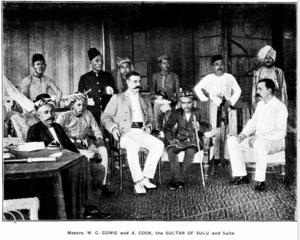
There is a disagreement over the eastern part of Sabah, which is now in Malaysia. The Philippines claims this area. This claim comes from the Sultanate of Sulu's historical ownership. Sabah was known as North Borneo before Malaysia was formed in 1963.
The dispute is about how to understand the 1878 agreement between the Sultanate of Sulu and the British company. The Philippines believes it was a lease, meaning the land was only rented. Malaysia believes it was a cession, meaning the land was given away permanently.
Malaysia considers this dispute settled. They believe the people of Sabah chose to join Malaysia in 1963. The British government also continued to make annual payments to the Sultan's heirs. These payments were called "cession money" in the receipts.
In 2013, Malaysia stopped these payments. This was after an attempted invasion of Sabah. Malaysia saw this as a violation of the 1878 agreement.
In 2022, an international court ruled that Malaysia had violated the 1878 treaty. It said Malaysia should pay a large sum to the Sultan's descendants. Malaysia disagreed with this ruling and tried to cancel it.
In June 2023, a court in Paris, France, ruled in favor of Malaysia. It said the arbitration court did not have the right to make the 2022 decision. However, the Sultan's heirs are still trying to claim Malaysian assets in other countries.
Economy of Sulu
Trade and Weapons
Chinese traders played a big role in Sulu's economy. They helped supply weapons to the local leaders (datus) and sultans. These weapons were used to fight against the Spanish. In return, the Moros traded people and other goods for guns. The Chinese took control of much of the Sultanate's trade. They used ships to export and import goods like ivory, textiles, and pottery.
In 1887, the Spanish attacked the Sultanate's capital at Maimbung. They captured weapons and destroyed Chinese property. The Chinese traders were then sent to Jolo.
Pearling Industry
After the pirate raids ended, Sulu's economy faced problems. It had relied on capturing people. The Sultanate's capital moved to Maimbung. Here, Sultan Jamalul Kiram II and his advisor Hadji Butu started the Sulu pearling industry. This helped increase the Sultan's wealth. The Sultan's pearling fleet was active into the early 1900s. In 1910, the Sultan reportedly sold a very large pearl for a lot of money.
Sulu Culture
Social Classes
In the Sultanate of Sulu, social status was based on family background.
The two main social classes were:
- Datu (su-sultanun): This title was passed down through families. All male members of the royal family were called "His Royal Highness." Their wives were called dayang dayang (princess).
- Datu sadja: This title could be given to commoners. It was for those who showed great bravery or did important services for the Sultan. These leaders were called "His Excellency." Their wives were called dayang.
Commoners were called maharlika. They did not come from royal families. Important positions in the government were held by commoners. These included:
- Wakil Kesultanan – a representative outside the Sulu Sultanate.
- Panglima – a representative inside the Sulu Sultanate.
- Parkasa – an assistant to a regional representative.
- Laksaman – a sub-region representative.
Men holding these offices were called tuan. Women holding these offices were called Sitti.
A large part of Sulu society included people captured from raids or bought from markets. They were known as bisaya. They were often from the Visayan islands. These people were treated like commoners. They had their own homes and worked on farms and fisheries for the nobility.
Visual Arts
The Sultanate of Sulu had a rich tradition of decorative arts. This art style is called okir or ukkil. Ukkil is a Tausug word for "wood carving." The Tausug and Maranao people carved and decorated their boats, houses, and even grave markers with ukkil designs.
Ukkil designs often use geometric patterns and flowing lines. They include floral and leaf patterns, as well as folk art elements. These designs were also found on clothing. Weapons like the kris and barong knives had beautifully decorated handles and blades with ukkil patterns. Bronze cannons (lantaka) also featured these designs.
Gallery
A yellow-colored flag was used in Sulu by the Chinese.
-
A war flag of the Sultanate of Sulu at the end of the 19th century
See also
- 2013 Lahad Datu standoff
- List of sultans of Sulu
- Sultanate of Malacca
- Sultanate of Maguindanao
- History of the Philippines (Before 1521)
- Kiram-Bates Treaty
- Moro history
- Moro Rebellion




